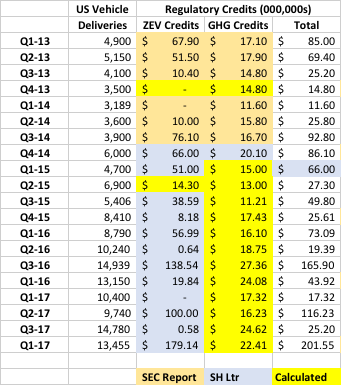Since inception, Tesla (TSLA) has generated over $1.4 billion in incremental revenue from sales of ZEV and GHG Credits. While Tesla’s reporting of revenue from ZEV and GHG sales has been patchy and inconsistent, my first table summarizes my estimates of Tesla’s revenues from ZEV and GHG Credit sales during the five years ended December 2017. Quarterly Vehicle delivery estimates are derived from monthly estimates published by Inside EVs. ZEV and GHG Credit estimates are derived and/or estimated from granular information in Tesla’s SEC reports and shareholder letters.

My second table shows how the prices Tesla received for ZEV and GHG Credits have softened over the last five years as the supply of credits increased. This second table is not as precise as the first because it ignores the possibility of unrealized credit inventories and divides annual ZEV Credit sales by total US Vehicle deliveries to arrive at a per vehicle number. While the methodology works for GHG Credits because those credits are earned on every car delivered in the US, it understates the per vehicle value of ZEV Credits because it divides total ZEV Credits by total US Vehicle deliveries. A more accurate analysis would divide total ZEV Credits by total vehicle deliveries in ZEV states but I haven’t been able to find that statistic. If you assume that the proportion of Tesla’s sales in ZEV and non-ZEV states is relatively stable from year to year, the inaccuracy becomes unimportant.
















Leave A Comment